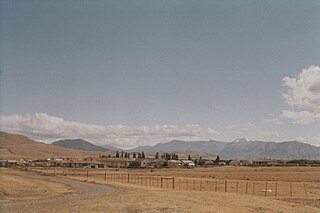
Nirivilo is a hamlet (caserío) in San Javier commune, in the Chilean province of Linares, Maule Region. It offers some remarkable examples of typical Chilean rural architecture. Its parish church dates from colonial times and is a National Monument.

Punucapa is a hamlet of pre-Hispanic origin in Los Ríos Region, Chile. Its isolated location by the Cruces River and the Valdivian Coastal Range has made the village an ecotourism attraction. The wetlands of the river is the home to thousands of birds; the black-necked swan is the most emblematic. Punucapa is inhabited by 75 people according to INE's 2002 census.
Riñihue is a hamlet in Los Lagos, Chile. It is located south of the Tralcán Mount in the west side of Riñihue Lake. In early 20th century Riñihue grew out as a settlement due to the exploitation of wood in Riñihue Lake. Riñihue was the first Chilean lakeshore settlement to be reached by the railroad. The hamlet is known for being flooded during the Riñihuazo.
Caleta Chaihuín (Chaihuín) is a coastal hamlet and rural district in the commune of Corral, Los Ríos Region, Chile. It lies at the mouth of Chaihuín River that flows from the Valdivian Coast Range to the Pacific Ocean. Silt from the river combined with the prevailing coastal current have formed a barrier-bar across the cove creating an estuary. The administration and main entrance to the Valdivian Coastal Reserve lies in Chaihuín.
Río Guanaco is a hamlet on Navarino Island in the Tierra del Fuego archipelago in southern Chile. It is part of the Cabo de Hornos commune in Antártica Chilena Province.

Cerro Castillo is a hamlet southeast of Torres del Paine National Park, and is the head of Torres del Paine commune, in Magallanes Region.
Pishuinco is a hamlet in the commune of Valdivia, Chile. It lies at the northern end of the Calle-Calle River between the city of Valdivia and Antilhue.
Guape is a hamlet located at coast between Caleta Chaihuín and the port of Corral in Valdivia Province, southern Chile.
Cabeceras is a Chilean hamlet (caserío) located in Paredones, Cardenal Caro Province.
Las Cabeceras is a Chilean hamlet (caserío) located in Paredones, Cardenal Caro Province.
Cabo Blanco is a Chilean hamlet (caserío) located in Valdivia, Valdivia Province, Los Ríos Region.
Hueicolla is a beach and hamlet at the sparsely populated coast of La Unión commune, southern Chile. Hueicolla is located south of Colún Beach, west of Alerce Costero National Park and Cordillera Pelada and north of the mouth of Bueno River.
Puerto Cárdenas is a lakeside hamlet at the outflow of Yelcho Lake in Chaitén commune, southern Chile. Carretera Austral passes by the hamlet.
Puaucho is a hamlet located in the West of Osorno Province, southern Chile. Puaucho is the administrative centre of San Juan de la Costa commune.
Los Conales is a hamlet eight kilometers north of the city of La Unión. The hamlets lies along the Southern Railway of Chile.
Cayurruca is a hamlet located in the commune of Río Bueno in Los Ríos Region, southern Chile.
Trumao is the name of two hamlets in Chile each located in front of the other on the shores of Bueno River. The northern hamlet belong to the La Unión commune and the southern to San Pablo commune.
Llancacura is a hamlet located at northern shores of Bueno River west of city of La Unión in Ranco Province, southern Chile. It lies upstream of La Barra and downstream of Trumao. Forestry has long been the driving economic activity in the hamlet.
Repollal is group of hamlets in Ascención Island of Guaitecas Archipelago, southern Chile. Repollal consists from north to south of three hamlets; Repollal Alto, Repollal Medio and Repollal Bajo. All the hamlets lie to the west of Melinka which is the only town in the archipelago. In 2002 the population of Repollal Alto was 81, in Repollal Medio it was 7 and in Repollal Bajo 36. Repollal is connected to Melinka by a gravel road. The population of Repollal is made up descendants of settlers from Chiloé Archipelago.





